Satas D., Tracton A.A. (ed.). Coatings Technology Handbook
Подождите немного. Документ загружается.

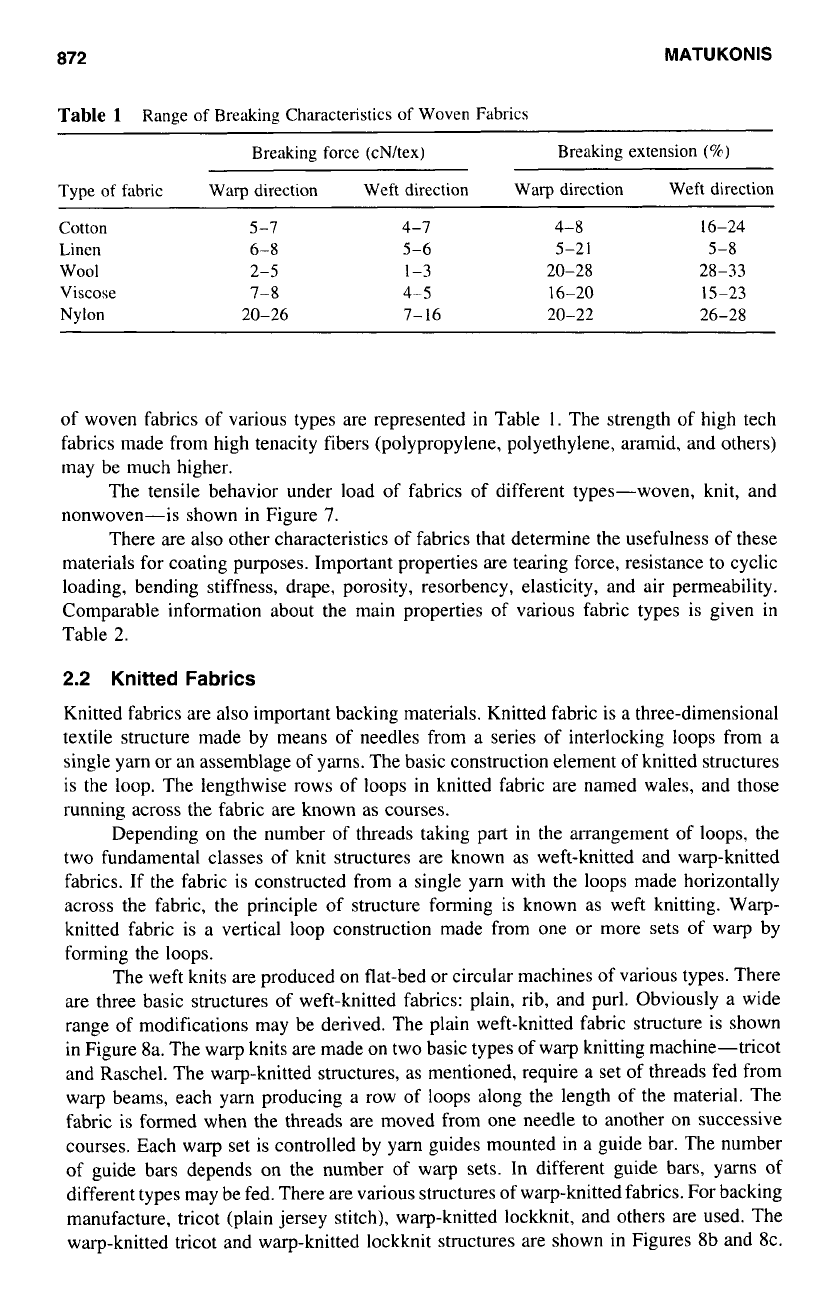
872
MATUKONIS
Table
1
Range of Breaking Characteristics of Woven Fabrics
~ ~
Cotton
5-7
4-7 4-8
16-24
Linen
6-8
5-6 5-21 5-8
Wool
2-5
1-3 20-28
28-33
Viscose
7-8
4-5 16-20
1
S-23
Nylon
20-26
7-
16 20-22
26-28
of woven fabrics of various types are represented in Table
1.
The strength of high tech
fabrics made from high tenacity fibers (polypropylene, polyethylene, aramid, and others)
may be much higher.
The tensile behavior under load
of
fabrics of different types-woven, knit, and
nonwoven-is shown in Figure
7.
There
are
also
other characteristics of fabrics that determine the usefulness of these
materials for coating purposes. Important properties are tearing force, resistance to cyclic
loading, bending stiffness, drape, porosity, resorbency, elasticity, and air permeability.
Comparable information about the main properties
of
various fabric types is given in
Table
2.
2.2
Knitted
Fabrics
Knitted fabrics are
also
important backing materials. Knitted fabric is
a
three-dimensional
textile structure made by means of needles from
a
series of interlocking loops from
a
single yarn or an assemblage of yarns. The basic construction element
of
knitted structures
is the loop. The lengthwise rows of loops
in
knitted fabric are named wales, and those
running across the fabric are known
as
courses.
Depending
on
the number of threads taking part in the arrangement of loops. the
two fundamental classes of knit structures are known
as
weft-knitted and warp-knitted
fabrics. If the fabric is constructed from
a
single yarn with the loops made horizontally
across the fabric, the principle of structure forming is known
as
weft knitting. Warp-
knitted fabric is
a
vertical loop construction made from one
or
more sets of warp by
forming the loops.
The weft knits are produced on flat-bed or circular machines of various types. There
are three basic structures of weft-knitted fabrics: plain, rib, and purl. Obviously
a
wide
range
of
modifications may be derived. The plain weft-knitted fabric structure is shown
in Figure
8a.
The warp knits are made on two basic types of warp knitting machine-tricot
and Raschel. The warp-knitted structures,
as
mentioned, require
a
set of threads fed from
warp beams, each yarn producing a row of loops along the length of the material. The
fabric is formed when the threads are moved from one needle to another on successive
courses. Each warp set is controlled by yarn guides mounted in a guide bar. The number
of
guide bars depends on the number of warp sets. In different guide bars, yarns
of
different types may be fed. There are various structures of warp-knitted fabrics. For backing
manufacture, tricot (plain jersey stitch), warp-knitted lockknit, and others are used. The
warp-knitted tricot and warp-knitted lockknit structures are shown in Figures 8b and 8~.
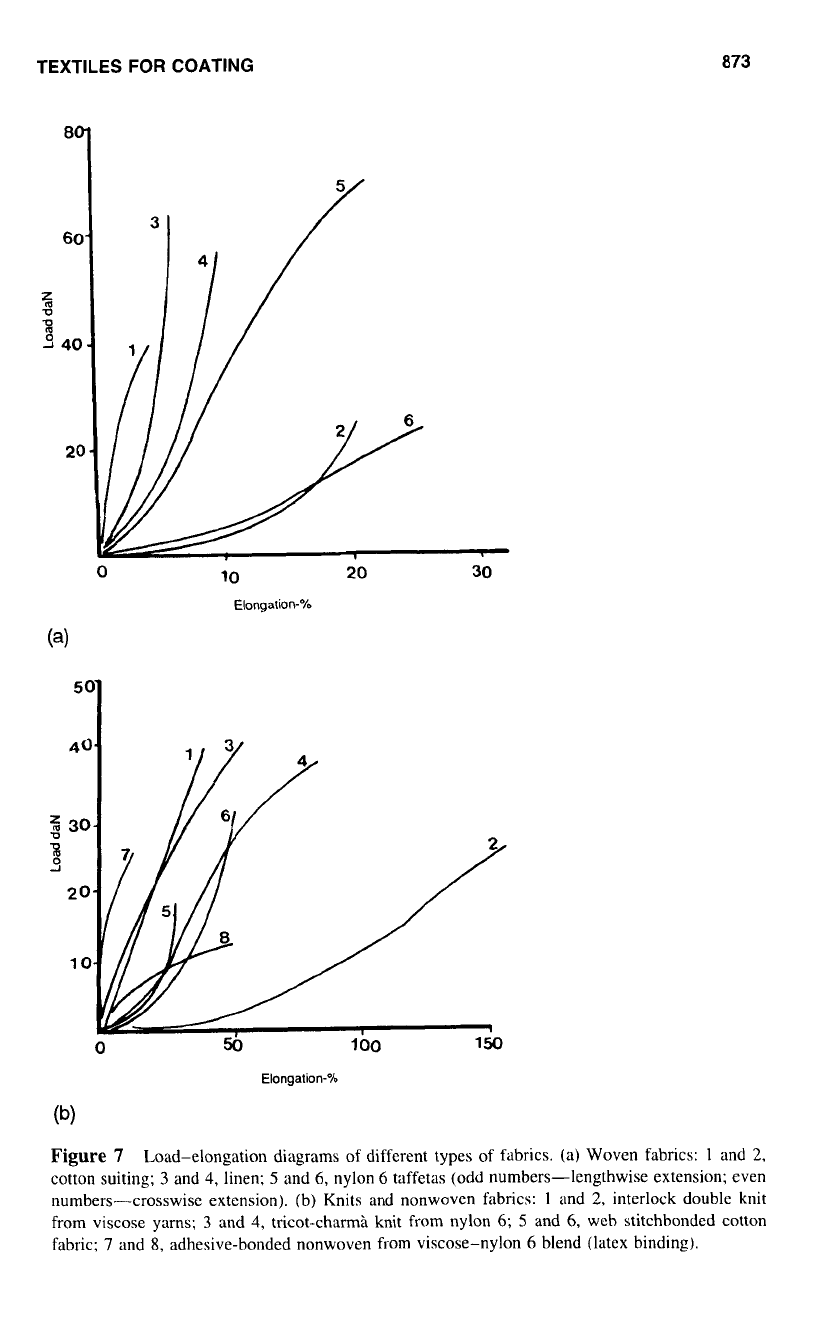
TEXTILES
FOR COATING
80
60
T
U
%
-I
40
PC
0
10
20
Elongation-%
(4
873
Elongation-%
Figure
7
Load-elongation diagrams of different types
of
fabrics. (a) Woven fabrics:
1
and
2,
cotton suiting;
3
and
4,
linen;
5
and
6,
nylon
6
taffetas (odd numbers-lengthwise extension; even
numbers-crosswise extension). (b) Knits and nonwoven fabrics:
1
and
2,
interlock double knit
from viscose yarns;
3
and
4,
tricot-charmi knit from nylon
6;
5
and
6,
web stitchbonded cotton
fabric;
7
and
8,
adhesive-bonded nonwoven from viscose-nylon
6
blend (latex binding).
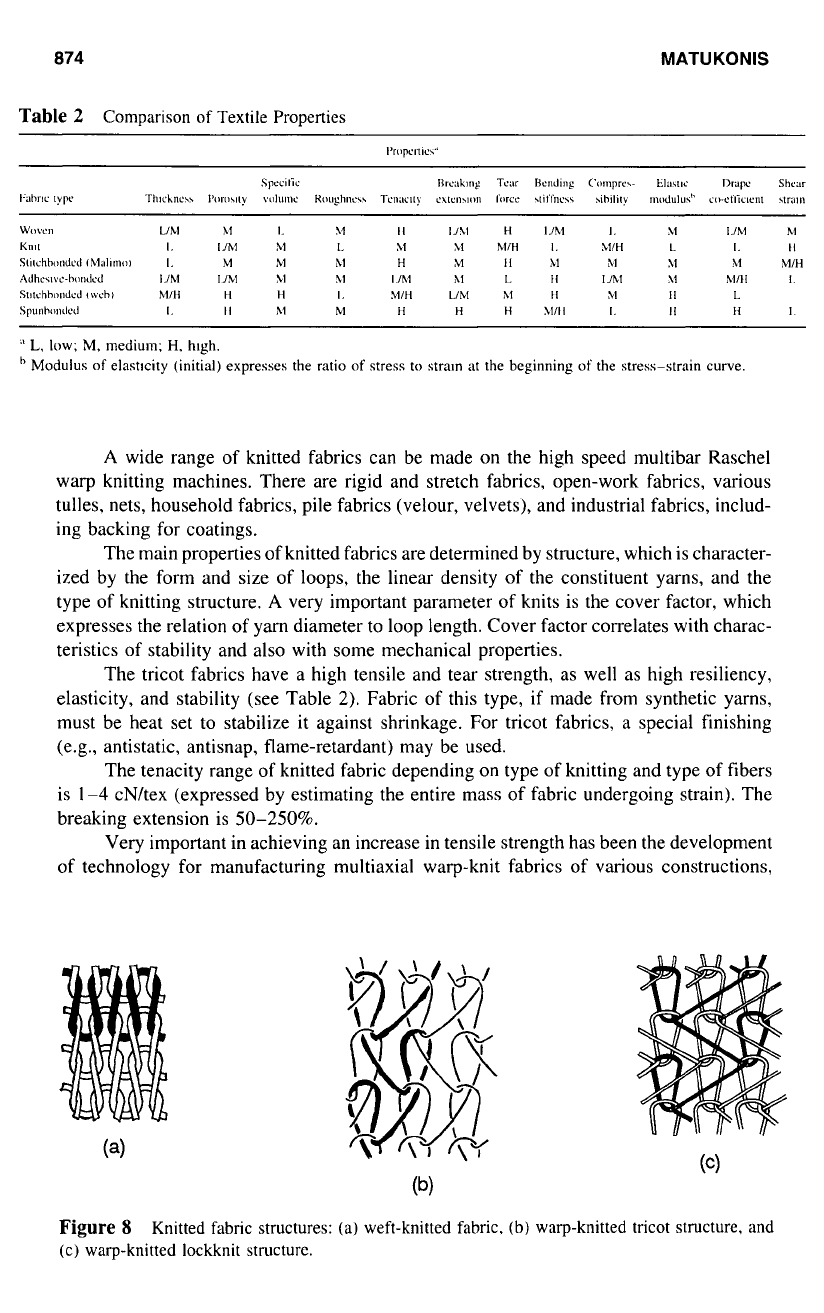
874
MATUKONIS
Table
2
Comparison of Textile Properties
.'
L,
low;
M, medium;
H,
hlgh.
h
Modulus
of
elastlcity (initial) expresses the ratio
of
stress
to
stram at the beginning
of
the stress-strain curve.
A
wide range of knitted fabrics can be made on the high speed multibar Raschel
warp knitting machines. There are rigid and stretch fabrics, open-work fabrics, various
tulles, nets, household fabrics, pile fabrics (velour, velvets), and industrial fabrics, includ-
ing backing for coatings.
The main properties of knitted fabrics are determined by structure, which is character-
ized by the form and size of loops, the linear density of the constituent yarns, and the
type of knitting structure.
A
very important parameter
of
knits is the cover factor, which
expresses the relation
of
yarn diameter to loop length. Cover factor correlates with charac-
teristics of stability and also with some mechanical properties.
The tricot fabrics have
a
high tensile and tear strength,
as
well as high resiliency,
elasticity, and stability (see Table
2).
Fabric of this type, if made from synthetic yarns,
must be heat set to stabilize it against shrinkage. For tricot fabrics, a special finishing
(e.g., antistatic, antisnap, flame-retardant) may be used.
The tenacity range of knitted fabric depending
on
type of knitting and type of fibers
is
1-4
cN/tex (expressed by estimating the entire mass of fabric undergoing strain). The
breaking extension is
50-250%.
Very important in achieving an increase in tensile strength has been the development
of technology for manufacturing multiaxial warp-knit fabrics of various constructions,
Figure
8
Knitted fabric structures: (a) weft-knitted fabric.
(b)
warp-knitted tricot structure, and
(c) warp-knitted lockknit structure.
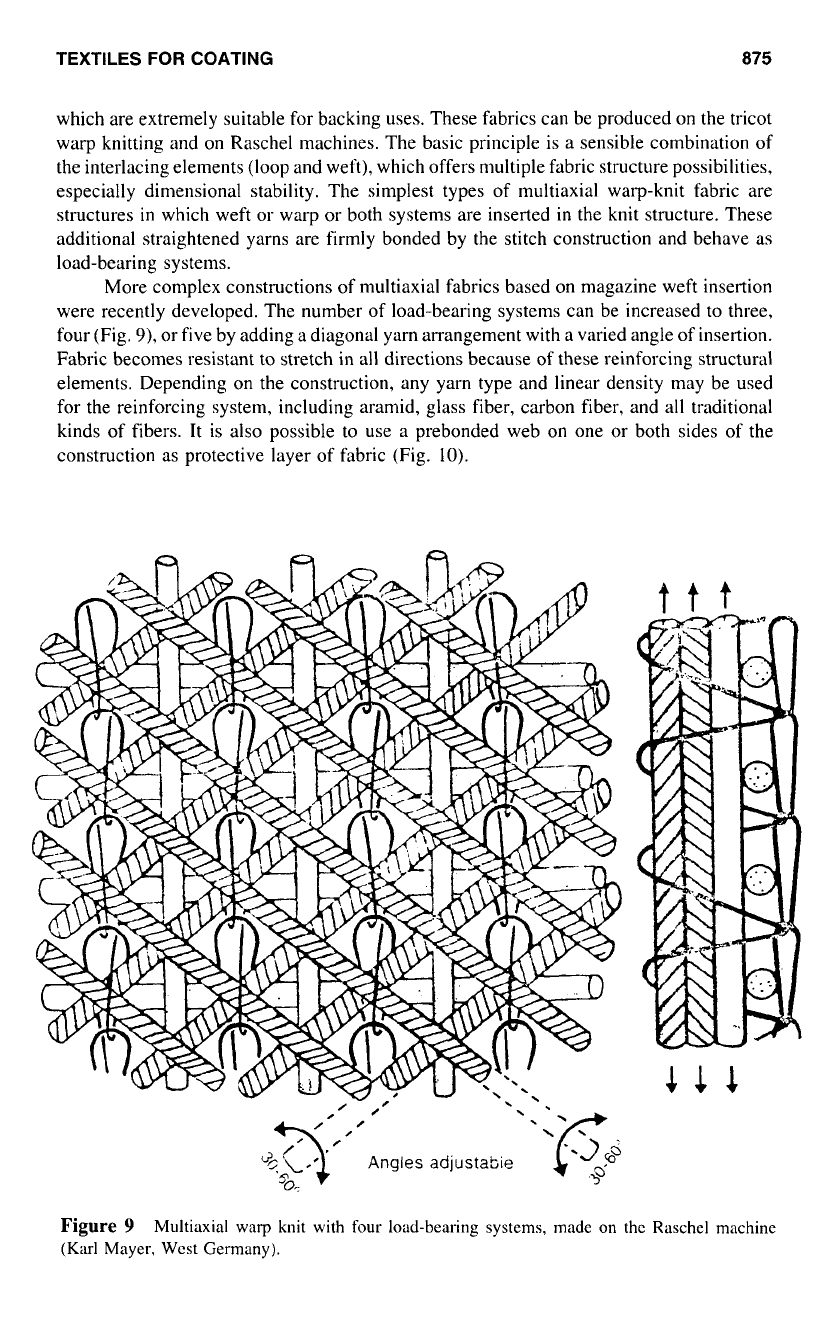
TEXTILES
FOR
COATING
875
which are extremely suitable for backing uses. These fabrics can be produced on the tricot
warp knitting and on Raschel machines. The basic principle is a sensible combination of
the interlacing elements (loop and weft), which offers nlultiple fabric structure possibilities,
especially dimensional stability. The simplest types of multiaxial warp-knit fabric are
structures
in
which weft or warp or both systems are inserted in the knit structure. These
additional straightened yarns are firmly bonded by the stitch construction and behave as
load-bearing systems.
More complex constructions
of
multiaxial fabrics based on magazine weft insertion
were recently developed. The number of load-bearing systems can be increased to three,
four (Fig.
9),
or five by adding a diagonal yarn arrangement with a varied angle
of
insertion.
Fabric becomes resistant to stretch in all directions because
of
these reinforcing structural
elements. Depending on the construction, any yarn type and linear density may be used
for the reinforcing system, including aramid, glass fiber, carbon fiber, and all traditional
kinds of fibers. It is also possible to use a prebonded web
on
one or both sides of the
construction as protective layer of fabric (Fig.
IO).
ttt
..
Figure
9
Multiaxial warp knit with four load-bearing systems, made on the
Raschel
machine
(Karl
Mayer,
West
Germany).
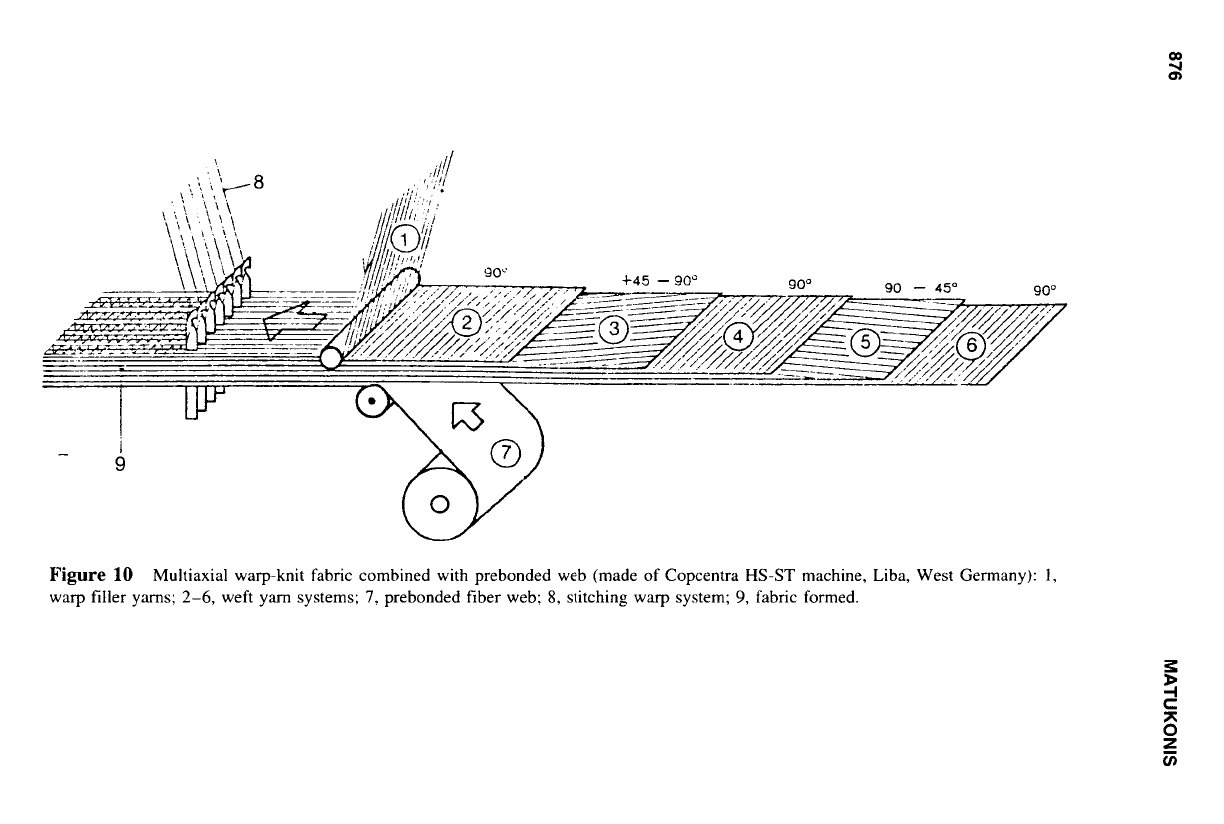
876
MATUKONIS
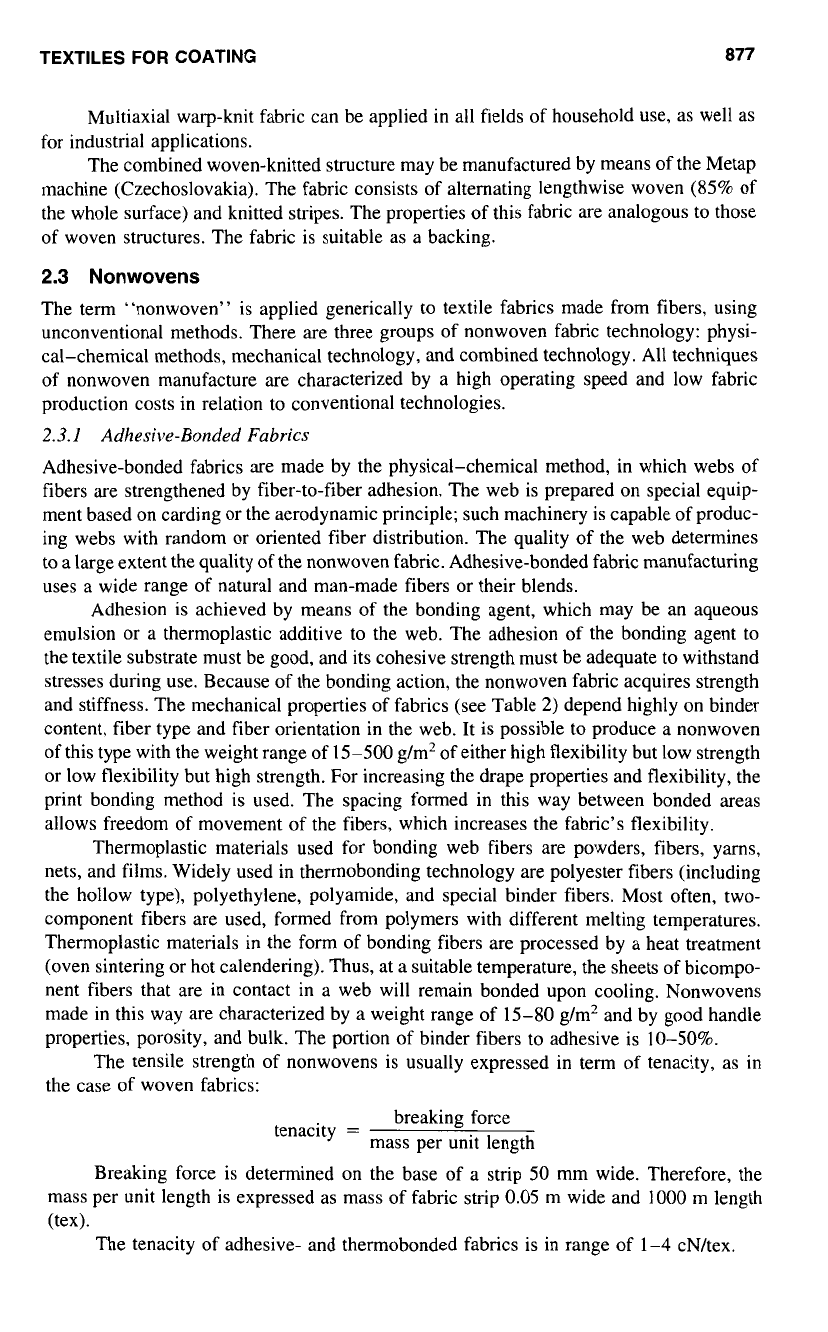
TEXTILES
FOR
COATING
877
Multiaxial warp-knit fabric can be applied in all fields of household use, as well as
for industrial applications.
The combined woven-knitted structure may be manufactured by means of the Metap
machine (Czechoslovakia). The fabric consists of alternating lengthwise woven
(85%
of
the whole surface) and knitted stripes. The properties of this fabric
are
analogous to those
of woven structures. The fabric is suitable as a backing.
2.3
Nonwovens
The term “nonwoven” is applied generically to textile fabrics made from fibers, using
unconventional methods. There are three groups of nonwoven fabric technology: physi-
cal-chemical methods, mechanical technology, and combined technology. All techniques
of
nonwoven manufacture are characterized by a high operating speed and low fabric
production costs in relation to conventional technologies.
2.3.1
Adhesive-Bonded Fabrics
Adhesive-bonded fabrics are made by the physical-chemical method, in which webs of
fibers are strengthened by fiber-to-fiber adhesion. The web is prepared on special equip-
ment based
on
carding or the aerodynamic principle; such machinery is capable of produc-
ing webs with random or oriented fiber distribution. The quality of the web determines
to a large extent the quality
of
the nonwoven fabric. Adhesive-bonded fabric manufacturing
uses a wide range of natural and man-made fibers or their blends.
Adhesion is achieved by means
of
the bonding agent, which may be an aqueous
emulsion or a thermoplastic additive to the web. The adhesion of the bonding agent to
the textile substrate must be good, and its cohesive strength must be adequate to withstand
stresses during use. Because of the bonding action, the nonwoven fabric acquires strength
and stiffness. The mechanical properties of fabrics (see Table
2)
depend highly
on
binder
content, fiber type and fiber orientation in the web. It is possible
to
produce a nonwoven
of this type with the weight range of
15-500
g/m2 of either high flexibility but low strength
or low flexibility but high strength. For increasing the drape properties and flexibility, the
print bonding method is used. The spacing formed in this way between bonded areas
allows freedom of movement of the fibers, which increases the fabric’s flexibility.
Thermoplastic materials used for bonding web fibers are powders, fibers, yarns,
nets, and films. Widely used in thermobonding technology are polyester fibers (including
the hollow type), polyethylene, polyamide, and special binder fibers. Most often, two-
component fibers are used, formed from polymers with different melting temperatures.
Thermoplastic materials in the form of bonding fibers are processed by a heat treatment
(oven sintering or hot calendering). Thus, at a suitable temperature, the sheets of bicompo-
nent fibers that are in contact in a web will remain bonded upon cooling. Nonwovens
made in this way are characterized by a weight range of
15-80
g/m’ and by good handle
properties, porosity, and bulk. The portion of binder fibers to adhesive is
10-50%.
The tensile strength of nonwovens is usually expressed in term of tenacity, as in
the case of woven fabrics:
tenacity
=
breaking force
mass per unit length
Breaking force is determined on the base of a strip
50
mm wide. Therefore, the
mass per unit length is expressed as mass of fabric strip
0.05
m wide and
1000
m length
(tex).
The tenacity of adhesive- and thermobonded fabrics is in range
of
1-4
cN/tex.
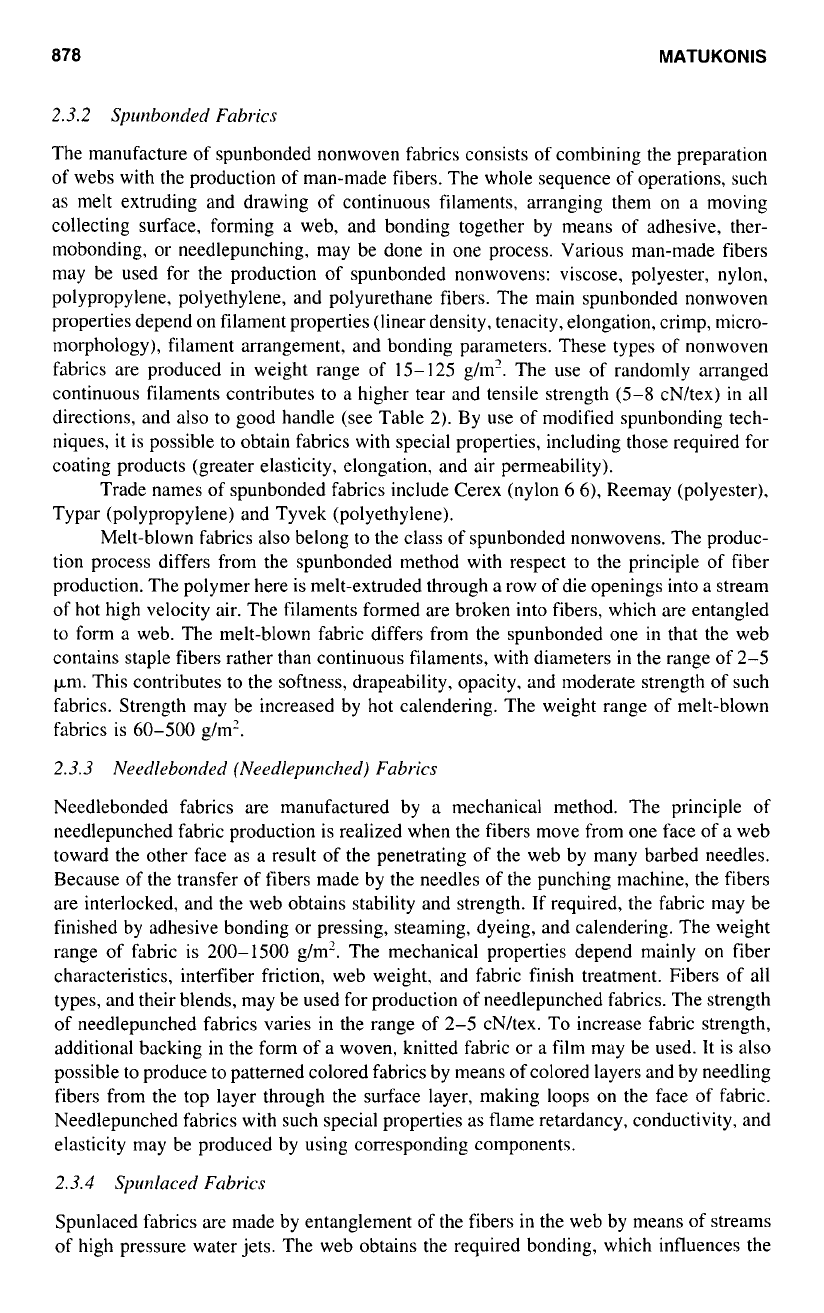
878
MATUKONIS
2.3.2
Sprnbonded Fabrics
The manufacture of spunbonded nonwoven fabrics consists of combining the preparation
of webs with the production of man-made fibers. The whole sequence of operations, such
as
melt extruding and drawing
of
continuous filaments, arranging them on a moving
collecting surface, forming
a
web, and bonding together by means of adhesive, ther-
mobonding, or needlepunching, may be done
in
one process. Various man-made fibers
may be used for the production of spunbonded nonwovens: viscose, polyester, nylon,
polypropylene, polyethylene, and polyurethane fibers. The main spunbonded nonwoven
properties depend on filament properties (linear density, tenacity, elongation, crimp, micro-
morphology), filament arrangement. and bonding parameters. These types of nonwoven
fabrics are produced in weight range of
15-125
gh'. The use of randomly arranged
continuous filaments contributes
to
a higher tear and tensile strength
(5-8
cN/tex) in all
directions, and
also
to good handle (see Table 2). By use of modified spunbonding tech-
niques,
it
is possible to obtain fabrics with special properties, including those required for
coating products (greater elasticity, elongation, and air permeability).
Trade names of spunbonded fabrics include Cerex (nylon 6
6),
Reemay (polyester),
Typar (polypropylene) and Tyvek (polyethylene).
Melt-blown fabrics
also
belong
to
the class of spunbonded nonwovens. The produc-
tion process differs from the spunbonded method with respect to the principle of fiber
production. The polymer here is melt-extruded through a row of die openings into
a
stream
of
hot high velocity air. The filaments formed are broken into fibers, which are entangled
to
form
a
web. The melt-blown fabric differs from the spunbonded one in that the web
contains staple fibers rather than continuous filaments, with diameters
in
the range of 2-5
km. This contributes to the softness, drapeability, opacity, and moderate strength
of
such
fabrics. Strength may be increased by hot calendering. The weight range of melt-blown
fabrics is 60-500 g/m'.
2.3.3
Needlebonded (Needlepuncketl) Fabrics
Needlebonded fabrics are manufactured by
a
mechanical method. The principle of
needlepunched fabric production is realized when the fibers move from one face of a web
toward the other face
as a
result of the penetrating of the web by many barbed needles.
Because of the transfer
of
fibers made by the needles of the punching machine, the fibers
are interlocked, and the web obtains stability and strength. If required, the fabric may be
finished by adhesive bonding or pressing, steaming, dyeing, and calendering. The weight
range of fabric is 200-1500 g/m'. The mechanical properties depend mainly on fiber
characteristics, interfiber friction, web weight, and fabric finish treatment. Fibers of all
types, and their blends, may be used for production of needlepunched fabrics. The strength
of needlepunched fabrics varies in the range
of
2-5 cN/tex. To increase fabric strength,
additional backing in the form of
a
woven, knitted fabric or a film may be used. It is also
possible to produce to patterned colored fabrics by means of colored layers and by needling
fibers from the top layer through the surface layer, making loops on the face of fabric.
Needlepunched fabrics with such special properties as flame retardancy, conductivity, and
elasticity may be produced by using corresponding components.
2.3.4
Sprnlaced Fabrics
Spunlaced fabrics are made by entanglement of the fibers in the web by means
of
streams
of
high pressure water jets. The web obtains the required bonding, which influences the
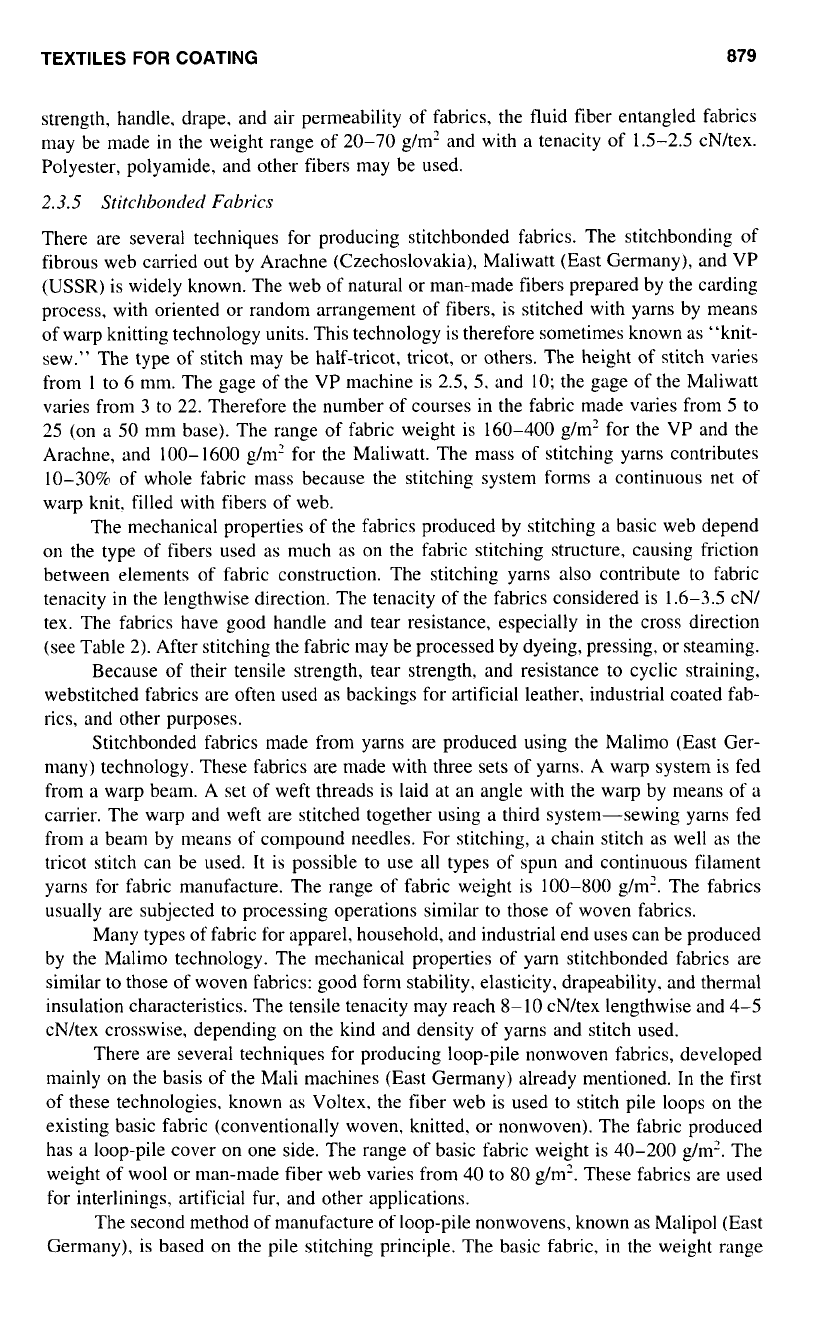
TEXTILES
FOR
COATING
879
strength, handle, drape, and air permeability
of
fabrics, the fluid fiber entangled fabrics
may be made in the weight range of 20-70 g/m’ and with
a
tenacity
of
1.5-2.5 cN/tex.
Polyester, polyamide, and other fibers may be used.
2.3.5
Stitchborlded
Fabrics
There are several techniques for producing stitchbonded fabrics. The stitchbonding of
fibrous web carried out by Arachne (Czechoslovakia), Maliwatt (East Germany), and VP
(USSR)
is widely known. The web of natural or man-made fibers prepared by the carding
process, with oriented or random arrangement of fibers, is stitched with yarns by means
of warp knitting technology units. This technology is therefore sometimes known as “knit-
sew.” The type
of
stitch may be half-tricot, tricot, or others. The height
of
stitch varies
from
1
to
6
mm. The gage of the VP machine is 2.5,
5.
and
IO;
the gage of the Maliwatt
varies from
3
to 22. Therefore the number of courses in the fabric made varies from
5
to
25 (on
a
50
mm base). The range of fabric weight is 160-400 g/m’ for the VP and the
Arachne, and
100-
1600
g/m’ for the Maliwatt. The
mass
of stitching yarns contributes
10-30%
of whole fabric mass because the stitching system forms
a
continuous net of
warp knit. filled with fibers of web.
The mechanical properties
of
the fabrics produced by stitching a basic web depend
on
the type of fibers used as much as on the fabric stitching structure, causing friction
between elements of fabric construction. The stitching yarns also contribute to fabric
tenacity
in
the lengthwise direction. The tenacity of the fabrics considered is
1.6-3.5
cN/
tex. The fabrics have good handle and tear resistance, especially in the cross direction
(see Table 2). After stitching the fabric may be processed by dyeing, pressing. or steaming.
Because
of
their tensile strength, tear strength. and resistance to cyclic straining,
webstitched fabrics are often used
as
backings for artificial leather, industrial coated fab-
rics, and other purposes.
Stitchbonded fabrics made from yarns are produced using the Malimo (East Ger-
many) technology. These fabrics are made with three sets of yarns. A warp system is fed
from a warp beam. A set
of
weft threads is laid at an angle with the warp by means
of
a
carrier. The warp and weft are stitched together using
a
third system-sewing yarns fed
from a bean1 by means
of
compound needles. For stitching,
a
chain stitch
as
well
as
the
tricot stitch can be used. It is possible
to
use all types
of
spun and continuous filament
yarns for fabric manufacture. The range of fabric weight is 100-800 &/m’. The fabrics
usually are subjected
to
processing operations similar
to
those of woven fabrics.
Many types of fabric for apparel. household, and industrial end uses can be produced
by the Malimo technology. The mechanical properties of yarn stitchbonded fabrics are
similar
to
those of woven fabrics: good form stability. elasticity, drapeability. and thermal
insulation characteristics. The tensile tenacity may reach
8-10
cN/tex lengthwise and
4-5
cN/tex crosswise, depending on the kind and density of yarns and stitch used.
There are several techniques for producing loop-pile nonwoven fabrics, developed
mainly
on
the basis of the Mali machines (East Germany) already mentioned. In the first
of these technologies. known as Voltex. the fiber web is used to stitch pile loops on the
existing basic fabric (conventionally woven, knitted, or nonwoven). The fabric produced
has
a
loop-pile cover on one side. The range
of
basic fabric weight is 40-200 &/m’. The
weight of
wool
or man-made fiber web varies from
40
to
80
g/m’. These fabrics are used
for interlinings, artificial fur, and other applications.
The second method of manufacture of loop-pile nonwovens, known
as
Malipol (East
Germany), is based on the pile stitching principle. The basic fabric,
in
the weight range
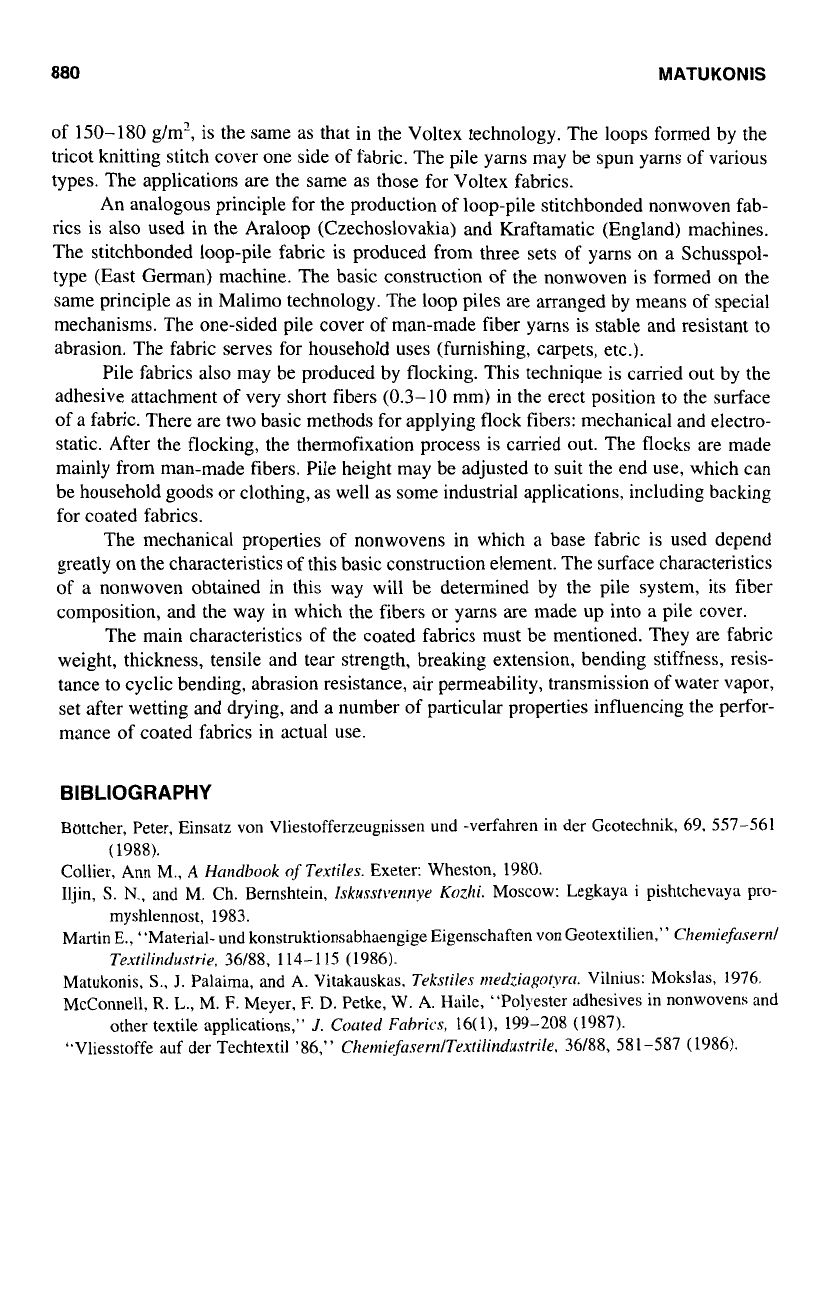
aao
MATUKONIS
of
150-180
g/m’, is the same as that in the Voltex technology. The loops formed by the
tricot knitting stitch cover one side of fabric. The pile yarns may be spun yams of various
types. The applications are the same as those for Voltex fabrics.
An analogous principle for the production of loop-pile stitchbonded nonwoven fab-
rics is also used in the Araloop (Czechoslovakia) and Kraftamatic (England) machines.
The stitchbonded loop-pile fabric is produced from three sets of yarns on a Schusspol-
type (East German) machine. The basic construction of the nonwoven is formed on the
same principle as in Malimo technology. The loop piles are arranged by means of special
mechanisms. The one-sided pile cover of man-made fiber yarns is stable and resistant to
abrasion. The fabric serves for household uses (furnishing, carpets, etc.).
Pile fabrics also may be produced by flocking. This technique is camed out by the
adhesive attachment
of
very short fibers
(0.3-10
mm) in the erect position to the surface
of
a fabric. There are two basic methods for applying flock fibers: mechanical and electro-
static. After the flocking, the thermofixation process is carried out. The flocks are made
mainly from man-made fibers. Pile height may be adjusted to suit the end use, which can
be household goods or clothing, as well as some industrial applications, including backing
for coated fabrics.
The mechanical properties of nonwovens in which a base fabric is used depend
greatly on the characteristics of this basic construction element. The surface characteristics
of a nonwoven obtained in this way will be determined by the pile system, its fiber
composition, and the way in which the fibers or yarns are made up into a pile cover.
The main characteristics of the coated fabrics must be mentioned. They are fabric
weight, thickness, tensile and tear strength, breaking extension, bending stiffness, resis-
tance to cyclic bending, abrasion resistance, air permeability, transmission of water vapor,
set after wetting and drying, and a number of particular properties influencing the perfor-
mance
of
coated fabrics in actual use.
BIBLIOGRAPHY
Battcher, Peter, Einsatz von Vliestofferzcugnissen und -verfahren
in
der Geotechnik,
69, 557-561
Collier, Ann M.,
A
HcrndOook
of
Textiles.
Exeter: Wheston,
1980.
Iljin,
S.
N.,
and M. Ch. Bernshtein,
Iskusst~wmye
Kozhi.
Moscow: Legkaya
i
pishtchevaya pro-
Martin
E.,
“Material- und konstruktionsabhaengige Eigenschaften von Geotextilien,”
Chen?iefnsertz/
Matukonis,
S.,
J.
Palaima, and
A.
Vitakauskas.
Tekstiles
tnedi!iagolyrrc.
Vilnius: Mokslas,
1976.
McConnell,
R.
L.,
M.
F.
Meyer,
F.
D.
Petke, W.
A.
Haile, “Polyester adhesives in nonwovens and
“Vliesstoffe auf
der
Techtextil
’86,”
Clzet~liefctsrrn/Tex!ilindustrilr,
36/88,
58
1-587 (1986).
(1988).
myshlennost,
1983.
Texti/indus!rie.
36/88,
114-1
15
(1986).
other textile applications,”
J.
Cortkd
Fabrics,
16(
l),
199-208 (1987).
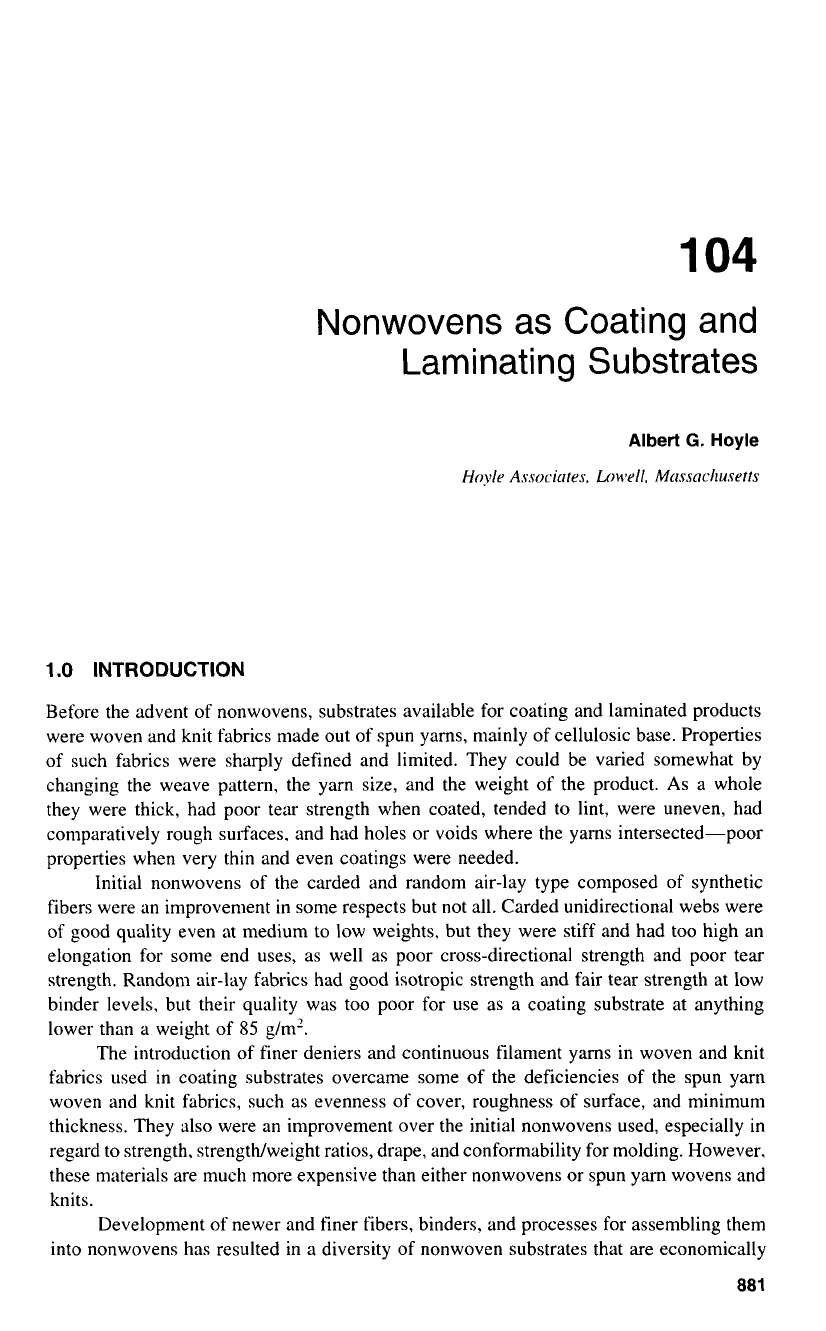
104
Nonwovens as Coating and
Laminating Substrates
Albert
G.
Hoyle
Hoyle
Associcrtes,
Lowell,
Mmsnchusetts
1
.O
INTRODUCTION
Before the advent of nonwovens, substrates available for coating and laminated products
were woven and knit fabrics made out of spun yarns, mainly of cellulosic base. Properties
of such fabrics were sharply defined and limited. They could be varied somewhat by
changing the weave pattern. the yarn size, and the weight of the product.
As
a
whole
they were thick, had poor tear strength when coated, tended
to
lint, were uneven, had
comparatively rough surfaces. and had holes or voids where the yarns intersected-poor
properties when very thin and even coatings were needed.
Initial nonwovens of the carded and random air-lay type composed of synthetic
fibers were an improvement
in
some respects but not all. Carded unidirectional webs were
of good quality even at medium to low weights, but they were stiff and had too high an
elongation for some end uses, as well
as
poor cross-directional strength and poor tear
strength. Random air-lay fabrics had good isotropic strength and fair tear strength at low
binder levels, but their quality was too poor for use as
a
coating substrate at anything
lower than a weight of
85
g/m’.
The introduction
of
finer deniers and continuous filament yams in woven and knit
fabrics used in coating substrates overcame some of the deficiencies of the spun yarn
woven and knit fabrics, such
as
evenness of cover, roughness of surface, and minimum
thickness. They
also
were an improvement over the initial nonwovens used, especially in
regard
to
strength. strengtwweight ratios, drape, and conformability for molding. However.
these materials are much more expensive than either nonwovens or spun yarn wovens and
knits.
Development of newer and finer fibers, binders. and processes for assembling them
into nonwovens has resulted in
a
diversity of nonwoven substrates that are economically
881
